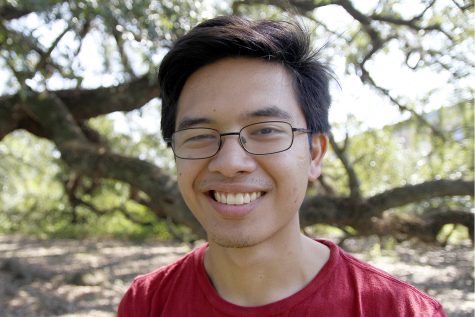
Assistant Professor of Biology Dr. Raul Diaz Jr. discusses his lab work and genome altering in the Science on Tap lecture on April 10. Zachary Araki/The Lion's Roar
The Science on Tap seminar series continued with Assistant Professor of Biology Dr. Raul Diaz Jr. discussing genome altering and body plan evolution.
“This is my first public talk, my first public talk in Hammond,” said Diaz. “I was very excited that the room was full. The room was engaged, and I saw some kids, saw a very diverse age group, background of the people here. I had fun bringing people into my weird world of chameleons and dinosaurs.”
Diaz presented “A Chameleon’s View on Body Modification and ‘Jurassic Park’” in Tope La Catering on April 10 at 7 p.m. Diaz selected his topic to provide a bigger perspective on his study of chameleons in the lab.
“The bigger picture of studying chameleons is that when you get to the genetics level, the genetics involved and the embryonic development applies to every living organism,” said Diaz. “Whether it’s for disease, looking at the evolution of body plans, it’s the same players involved, the same toolkit that you’re using, so combing paleontology and anatomy, genetics and transgenetics is one and the same for how can we alter the genome to answer our questions.”
Diaz discussed the inclusion of “Jurassic Park” in his talk for bringing “growing disciplines to the forefront of the public.”
Diaz said, “A lot of that was biotechnology, the new development of genetic techniques, introducing people to genomics, and of course now, this sort of predicted where all this technology was gonna go because de-extinction is something that is very important in modern times because we’re going through rapid losses. We just lost, I think, a species of rhino this last month, so finding how to have a bank of genomic data, how can we potentially bring them back is at the forefront of conservation questions.”
According to Diaz, he “bounced around like a ping pong ball” before getting into his field of study.
“I started off as a field biologist,” said Diaz. “I’d go to the tropical jungles, look for diversity in animals, how many species are there, what are they doing. That was basically it. Then I got interested in not just the differences that characterize the species, but what are the genetics behind those differences? How do those differences form embryonically? That pushed me away from just describing animals in the field to doing a lot of laboratory embryonic work.”
Diaz studies chameleons as part of body plan evolution.
“Now that I’ve sort of done a different topic for my different degrees, I’m combining them all now that I have my own lab,” said Diaz. “I still do field work. I breed my own animals in biology. I do lab work, and I’m taking a class to the Galápagos in a month.”
Diaz offered advice to students pursuing their own studies.
“Don’t be afraid to try a challenging new field ’cause you can always tie it back,” said Diaz. “I basically teach now all of the classes I avoided taking as an undergraduate, so you never know where you’re gonna wind up.”


